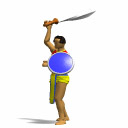I've noticed that the wonders list is a bit short and needs to be a bit more varied. Here are some more ideas for wonders:
Khajuraho Temple, Madhya Pradesh, India -a famous Hindu temple in India with elaborate carvings.
Cheomseongdae, Gyeongju, Korea - one of the oldest scientific structures in East Asia dating to 647 CE in the Unified Shilla period.
Su Song's "Cosmic Engine," Kaifeng, China - before it was dismantled by the invading Jurchen Jin Empire, this astronomical clock built in 1092 CE was the most advanced of its kind in the 11th century.
Potala Palace, Lhasa, Tibet - the home of the Dalai Lama before the Chinese invasion in the middle of the twentieth century.
Bamiyan, Afghanistan - before the Taliban blew them up, they were some of the most spectacular Buddhist grottoes in the world. The Buddhist grottoes of Datong, China were inspired by them.
Angkor Wat, Cambodia - Angkor Wat isn't just a temple; it's also a political statement. It was dedicated to Vishnu and was constructed to justify the rule of Suryavarman II, as some of the temple inscriptions characterize him as a sort of messianic figure.
Big Wild Goose Pagoda, Xi'an, China - built in 652 CE in the Tang Dynasty period, it was built to store the sutras that were brought back from India by the monk Xuanzang, whose journey inspired the novel "Journey to the West" (also known as "Monkey" to Europeans and Americans).
As far as the Taj Mahal being a wonder goes, I think someone pointed out here (forgot if it was Rambuchan or Blue Monkey) that while it is a gorgeous peice of architecture, at the time when it was built, the only person that it made happy was Shah Jahan.



